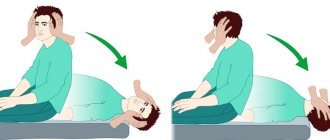Causes and symptoms of edema
The etiology of swelling on the legs and face is associated with the following reasons:
- genetic predisposition;
- allergic reactions;
- arrhythmia;
- obesity;
- varicose veins;
- hypotension;
- passive lifestyle;
- poor nutrition;
- severe heart disease;
- hormonal imbalance;
- lack of treatment for hypertension at an early stage of its manifestation;
- renal failure;
- drug, alcohol, nicotine addiction;
- uncontrolled use of certain medications;
- cirrhosis.
As you can see, there are quite a lot of reasons that provoke the formation of edema. They can develop as a result of thyrotoxicosis, coarctation of the aorta (congenital pathology), stenosis of the renal arteries, etc. Therefore, only an experienced specialist can determine the etiology of the appearance of edema in different parts of the body after conducting appropriate studies.
Symptoms
Swelling in arterial hypertension can manifest itself as the following symptoms:
- pain (discomfort) in the chest;
- increased sweating;
- feeling of pressure in the eyeballs;
- throbbing headache;
- chills;
- muscle weakness;
- dizziness;
- difficulty concentrating;
- vision problems;
- memory impairment;
- nausea;
- dyspnea;
- uneven pulse;
- chronic fatigue;
- periodic panic attacks;
- feeling of heaviness in the legs;
- insomnia;
- decreased amount of urine excreted;
- increased irritability;
- anxiety;
- swelling of the limbs and face;
- impaired coordination of movements (observed extremely rarely).
With facial swelling, patients often experience elevated levels of protein in their urine. In the initial stages of the disease, swelling on the face is detected only in the morning. Without adequate therapy, facial swelling does not go away within a day.
Advice.
If you experience the symptoms described above, consult a doctor immediately. If hypertension is not diagnosed in time and effective treatment is not prescribed, the disease will become chronic, which is fraught with the development of various kinds of complications.
When swelling gets out of control: anasarca
The appearance of swelling in the legs at the end of a long working day is unlikely to surprise anyone. And even slight swelling in the morning, as a rule, does not attract attention. But, if swelling becomes more and more noticeable and “spreads” throughout the body, you should not postpone the examination. In severe cases, anasarca occurs - swelling of the skin and subcutaneous tissue, usually combined with the accumulation of fluid in the body cavities. This is a sign of failure of compensatory mechanisms for a number of diseases, most often associated with congestive heart failure.
Edema and kidneys
The most obvious explanation for swelling that can “come to mind,” of course, is renal disorders.
There can be quite a few reasons for this pathology - from overload of the kidneys with “work” (a sharp increase in fluid intake) to serious pathologies (glomerulonephritis, damage to the renal vessels in diabetes, and others).
In the latter case:
- or the rate of urine formation significantly decreases;
- or, along with the urine, a protein is “lost”, which “holds” the liquid in the bloodstream, preventing the latter from “leaking” into the tissues.
Swelling, in this case, as a rule, begins from the face, since it is here that the subcutaneous fatty tissue is especially loose and “absorbent.” And, as they progress, they descend on the body and limbs.
You can check the condition of your kidneys using:
- general urine test
- and a blood test for glomerular filtration rate.
Edema and heart
Edema of cardiac origin is associated with a weakening of the heart’s ability to “pump” blood and form pulse pressure. And, in this case, venous blood “stagnates” in the vessels and, as a result, its liquid part (plasma) seeps into the tissues.
Cardiac edema most often begins in the legs, since here venous blood moves from bottom to top, and more than other locations it needs the “healthy” pumping function of the heart. And venous diseases are also a contributing factor to edema at this level.
The cause of cardiac “weakness” may be damage to the muscular apparatus of the heart or its valves (congenital defects, past streptococcal and some other infections). And, without attention, the pathology leads to severe breathing problems and pulmonary edema.
And to detect heart failure, a blood test for natriuretic peptide (BNP) and an ultrasound of the organ are indicated.
Edema and liver
It may seem strange, but the liver is the “culprit” of edema no less often than other organs.
The fact is that albumin is synthesized in the liver - a protein that, as already noted, acts as a “buffer” for the liquid part of the blood. A decrease in the production of the latter is observed in hepatitis and cirrhosis.
The hepatic origin of edema can be suspected on the basis of anamnestic data (frequent alcohol consumption, previous or chronic liver diseases), as well as the characteristic “ascitic” abdomen. When edematous fluid accumulates in the abdominal cavity, and against the background of normal or reduced body weight, only an enlarged abdomen stands out.
In this case, the liver should be checked for chronic hepatitis (at a minimum, a blood test for ALT, AST, direct bilirubin or the “Basic Liver Examination” complex) and degenerative changes (the “NESH-Fibrotest” blood test).
True, protein deficiency can also be a consequence of deficient nutrition, digestive pathologies that impair nutrient absorption, or accompany oncological processes (“cancerous” depletion).
And the level of albumin and globulins can be assessed using a blood test for protein fractions.
Edema and thyroid gland
Deficiency of T4 and T3 thyroid hormones sharply slows down all types of metabolic processes, and water-salt metabolism is no exception.
The liquid, in this case, accumulates in the subcutaneous fat, creating the impression of “puffiness”.
True, such edema most often does not pose a “deadly” danger. But they still serve as a good reason to check the health of the gland, since they are accompanied by a number of other abnormalities in a number of systems and organs (heart, carbohydrate and fat metabolism, immunity and others).
The terrible consequences of edema
Slow progression of untreated edema syndrome may be a sign of deterioration in the patient's condition due to chronic diseases.
The sudden appearance and rapid increase of edema should cause even greater concern, since it may be a sign of deep vein thrombosis (usually a limb) or an excessive allergic reaction. If such swelling occurs, you should immediately seek help.
Expert opinion
The chief physician of the Clinic of Doctor Shishonin, Alexander Yuryevich Shishonin, notes that edematous phenomena in hypertension have different localizations. Swelling of the legs and face is most common.
As A.Yu. explains Shishonin, the main reason for the appearance of such edema is that the patient constantly increases the dose of drugs to lower blood pressure. At the same time, the work of the heart is disrupted, it begins to get tired, and ceases to perform its main functions. The brain does not receive enough oxygen, myocardial ischemia and brain hypoxia develop. In addition, stagnation and intoxication phenomena are observed.
Join the Club of Former Hypertensive Patients
, download gymnastics, which has already helped hundreds of thousands of people overcome pressure surges and hypertension. Get the most current and correct information about problems related to blood pressure, osteochondrosis, atherosclerosis, ask your questions to Dr. Shishonin and just communicate.
Most often, swelling is diagnosed in the legs. Without adequate treatment, the heart wears out over time and ceases to “hold” pressure. For some people, blood pressure drops to 90/60. It is very difficult to restore such a group of patients.
With swelling of the face, stagnation of intracranial blood is observed. This occurs due to the fact that cervical osteochondrosis compresses the vertebral veins so much that it disrupts the outflow of blood from the brain and increases intracranial pressure. This condition can be called cerebral edema because most patients die when diagnosed with cerebral edema.
Most experienced hypertensive patients have a swollen face and a pasty state. Swelling goes away quickly if the heart works normally. In order to force blood into the head, the heart must be very strong.
People with facial swelling are a group of patients who show positive dynamics towards recovery. Specialists of the Club of Former Hypertensives have developed a whole range of physical exercises that help optimize blood pressure and relieve the symptoms of hypertensive edema.
Dr. Shishonin’s physical exercises help unblock the deep muscles of the neck, correct the position of the vertebrae and improve blood circulation in the body. In severe cases, A.Yu. Shishonin recommends using drug therapy.
The doctor notes that most of his patients with facial swelling have vascular spots localized between the scalp and neck. If patients have such spots, headaches, or problems with blood pressure, then they can take Dr. Shishonin’s drug-free course.
Swelling of the legs - reasons why legs swell
Only 10% of patients require more intensive testing, including laboratory and imaging methods. Understanding the mechanism of edema development allows the doctor not only to make a correct diagnosis, but also to prescribe the correct treatment.
Treatment of chronic edema of the lower extremities is pursued not so much for cosmetic purposes as for ensuring the normal functioning of the skin and soft tissues.
The fact is that oxygen and other nutrients enter the skin by penetrating through the vascular wall and further to the skin itself. In conditions of edema, this mechanism does not work. A decrease in metabolic processes leads to starvation of the skin, accumulation of metabolic products in them, deterioration of the barrier function of the skin and a decrease in its regenerative abilities. Clinically, this is manifested by a violation of the color of the skin; it acquires a bluish tint, and also becomes denser. In addition, edema fluid, rich in proteins, serves as a good breeding ground for a variety of microorganisms that cause inflammation. Thus, this is a strong motivation to start treatment.
Reasons why leg swelling occurs
It is extremely difficult to identify any main reason. Mostly swelling of the legs occurs:
Leg swelling associated with varicose veins can occur on one or both legs. If varicose veins progress on one leg, the swelling is usually asymmetrical. Varicose edema is localized in the lower leg area (below the knee). The foot, as a rule, does not swell. A typical sign of varicose veins is that they go away or are significantly reduced after a night's rest. When a finger is pressed for a long time on the skin in the shin area (below the knee), characteristic dimples remain. Complaints can range from a simple feeling of heaviness from swelling to a feeling of dull arching pain. Upon examination, you can detect other manifestations of varicose veins: varicose veins and skin changes in the form of cyanosis, thickening, etc.
Lymphedema (Lymphostasis), in contrast to venous pathology, is manifested by swelling of the feet and fingers. Swelling of the dorsum of the foot is compared to a “pillow”, and the toes are compared to “sausages”. Lymphedema usually does not decrease after a night's rest. In the initial stages of the disease, pits remain on the skin of the lower leg from squeezing with fingers. Subsequently, as a result of the development of compaction of the skin, the soft tissues of the lower leg become dense like a shell. With lymphedema, the skin on the back of the foot (the back of the sole) cannot be folded. As a rule, there are no complaints. Sometimes patients feel a feeling of heaviness in their calves. Lymphedema most often affects one lower limb.
Diseases of the heart, kidneys, liver, endocrine system and long-term hormonal therapy cause systemic (central) edema, appearing on both lower extremities and localized on the lower leg. The swelling is symmetrical and does not involve the dorsum of the foot and toes. When squeezed with a finger, permanent pits remain. Patient complaints are related to the underlying disease. Unpleasant sensations in the legs are minimal or completely absent.
Positional (hypodynamic, orthostatic) edema is difficult to distinguish from systemic edema. The main differential diagnostic feature in such cases is the limited mobility of patients. Positional swelling of the legs often occurs in patients confined to wheelchairs. Externally, such swelling levels the conical profile of the lower leg and makes it look like a cylinder. The patients have no complaints.
Leg swelling associated with taking pharmacological drugs is always bilateral and symmetrical. The intensity of swelling may decrease after a night's rest or elevation of the limbs, and, as a rule, such swelling quickly disappears after stopping the drugs. There are no or minimal complaints.
Also, an increase in the volume of the lower extremities may be associated not with edema, but with a non-standard distribution of adipose tissue. This condition is called lipedema.
Lipedema is inherited and appears already in adolescence. Such legs are often compared to a “tree trunk,” noting the abnormally large thickness of the ankles. The feet remain completely normal. Night rest, prolonged compression and diuretics have no effect. The skin and subcutaneous tissue with lipedema, in contrast to true edema, have a loose consistency. Complaints are minimal; sometimes patients note increased sensitivity of the skin to touch.
Principles of treatment of venous and lymphatic edema
Of course, due to the variety of causes for the development of edema, there are a large number of treatment methods, but we will try to highlight the main areas. So, if your legs are swollen you need to:
- Compression elastic knitwear (allows you to influence swelling from the outside and help reduce it)
- Prescription of drugs that improve venous tone (by increasing the tone of the veins, fluid outflows from the legs faster).
- It is important to change your lifestyle and prescribe a diet.
- Correction of fluid levels in the body (limiting salt intake, taking diuretics, etc.).
- Various physical procedures (lymphopress, lymphatic drainage massage, magnetic therapy, etc.)
Prevention of edema
To prevent the development of edematous phenomena, you need to follow some recommendations from your doctor:
- consume less salt in your diet;
- monitor your weight;
- avoid excessive physical activity;
- spend more time in the fresh air;
- include more fruits and vegetables in your diet.





